Every year, at the end of the year, we recap the market action for the just-completed year and discuss how our various services did. If you go back and look at prior year-end reports, I would say that we have done a fairly good job of anticipating what the year ahead holds as well.
For example, at the end of 2007, with oil rising above $80 a barrel and holding for the first time, we predicted a sharp decline and rocky 2008. That of course later turned into the banking collapse late in the year, which certainly was more extreme than we had in mind, but nevertheless, the prediction was a good one.
At the end of 2008, with the stimulus bill just passed and a new administration in town and the VIX just hitting a record spike, we predicted that 2009 would be one of the strongest up years in history, rivaling years like 1932 and 1933 when the government finally took steps to try to rectify the Great Depression. 2009 ended up being a huge year to the upside, and our calls did well again.
At the end of 2009, our goals for 2010 were much more moderate. We were looking for a small pause in January, another push higher, a 20% correction at some point in the year, and then a strong back end of the year, “hopefully with about a 35% push up.”
How did those items play out? Let’s look at our favorite index, the NASDAQ 100 (NDX):
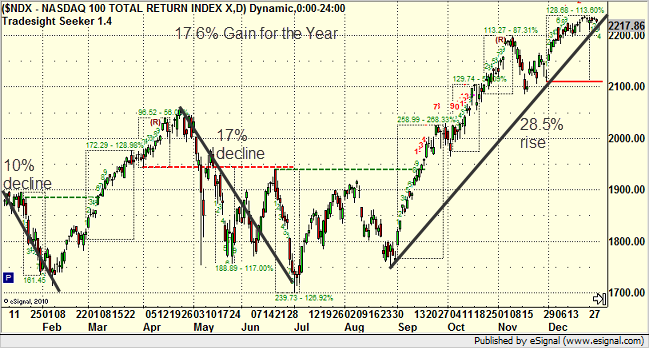
Pretty much got everything we wanted along with a modest 17% rise for the year on the index overall. No complaints.
The broader S&P 500 index was a little more moderate, showing a 10.5% gain for the year:

While things have settled down to more “normal” market returns after the run of 2009, there’s nothing to complain about here on the stock market side.
As I go through the rest of the various index charts, I’ve drawn a line from the start of the year to the end so you can see the net gain/loss.
The SOX performed well:
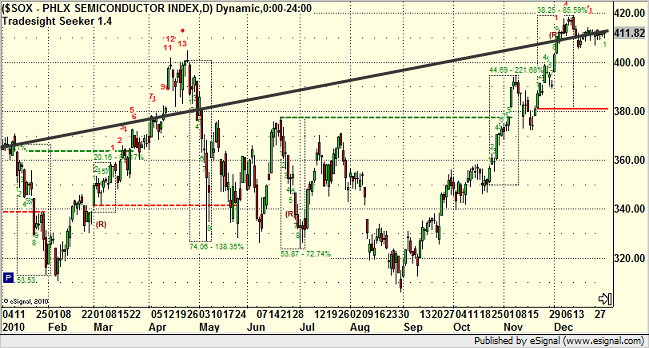
As did the Biotechs:
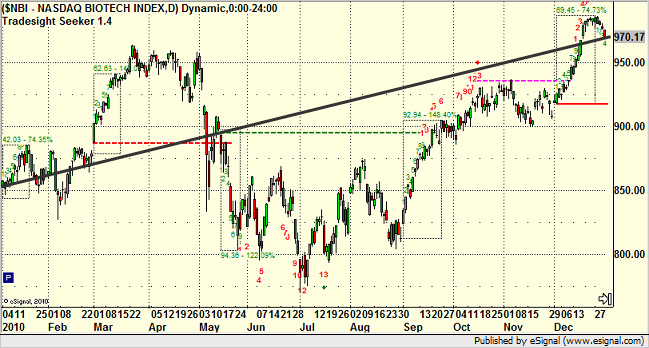
Banks finally had a decent year, although it should be noted that they did NOT close out at the high of the year like just about every other equity index did:
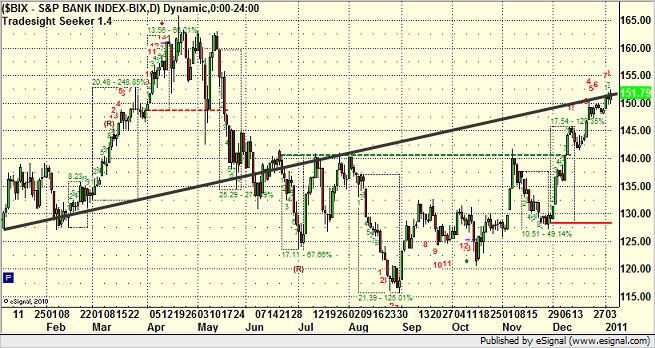
Part of what kept this year from posting a better rebound was the European debt crisis, which amplified during the middle of the year and definitely caused some concerns. This had an impact on gold, which we don’t really trade, but clearly didn’t create the bubble burst that we had been looking for coming into the year:

I will say this. If you look at a weekly chart of gold, the higher it goes, the worse the ultimate breakdown will be at some point, just like oil in 2008. The fact that it is a commodity doesn’t change the concept:
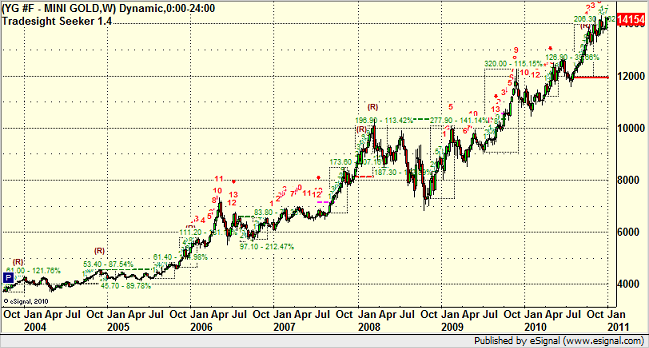
Treasuries barely made out a positive year after rallying harder mid-year during the peak of the European concerns:

Oil also was higher, although it had the narrowest range in five years ($20 a barrel in range):

It’s also stuck around the 50% retracement of the collapse in 2008:
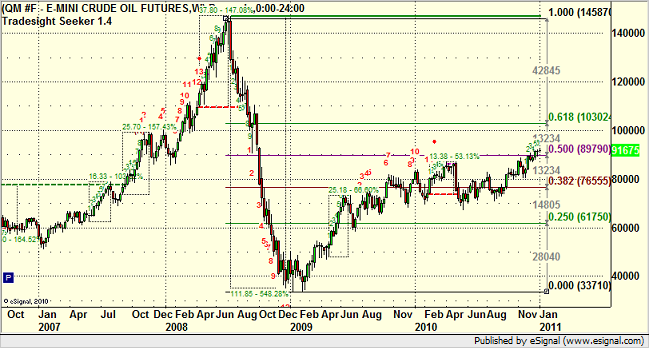
Oil will be important to watch in 2011. The “new normal” for oil after the last three years is that $100 a barrel is the “danger zone” that can again impact the global economy. Unless we start to see a bigger shift away from oil to other energy resources that meet our global needs, oil over $100 a barrel will be bad news and could be yet another major factor (there are several, we will discuss below) that could hurt the economy.
Before we get into Forex, let’s look briefly at some of the key stocks that we trade regularly did for the year.
AAPL remains my favorite trader, although it accounted for only 18% of my trades, which is a sharp drop from the last two years, owing more to the fact that there are other great active vehicles. It certainly had an up year and might suffer a bit in January as people can finally sell in 2011 and not pay taxes until 2012:

GOOG is another favorite, and while it remained great from a trading perspective, it had a down year, which is interesting to note. If this is a base, be on the long side of it when it breaks out:
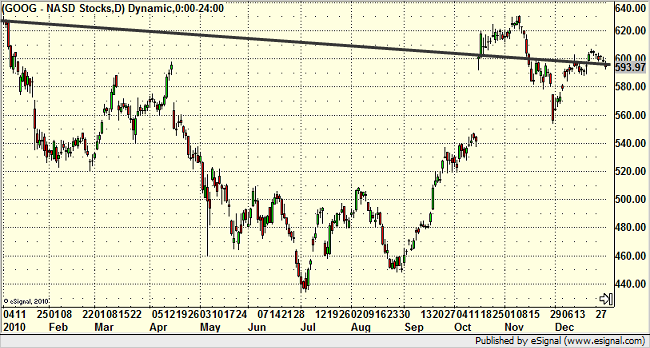
AMZN rose in my list and had a strong up year:
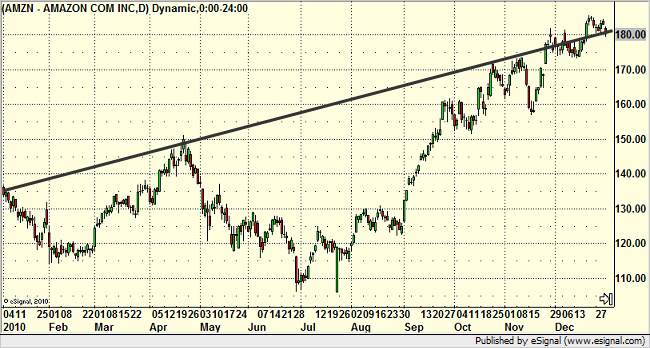
RIMM suffered some issues as the Blackberry OS lost market share to Android in particular, but it still has great trading moment:
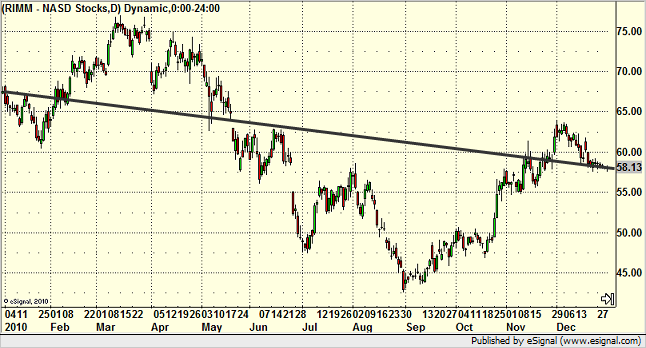
The real newbie from an active trading perspective was NFLX, which posted a massive 300% year and started trading much higher volume, making it a great intraday trader. This one benefits finally from Blockbuster getting the final nail in the coffin:

So how was the Forex market this year? In last year’s report, I said that we had more confidence that the US Dollar Index would post an up year and ultimately hit the 84-86 level. That move happened much earlier in the year than we were expecting as the Dollar was looking very strong right up until the European crisis really kicked in:

The Dollar still posted a positive year and if you back out the chart more, it is significantly higher than the low in the summer of 2008 as the banking crisis came into full swing (despite the fact that the news media has spent the last two years talking about the US Dollar getting weaker). You can also see that it now has a specific uptrend line in place from 4 points over two and a half years, although there is also a declining trendline in the shorter term, giving us a total wedge:
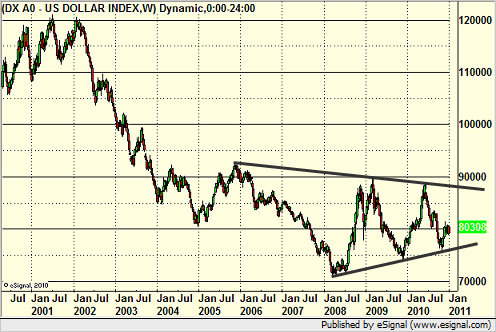
Those lines will be important to watch.
Looking back at the US Dollar daily chart, from a trading perspective, we like to see good ranges AND good movement for the majority of the year in Forex. Extended periods of flat and/or extended periods of lower ranges make trading more difficult. Here’s the chart again:

As you can see, this year started out terrific, with a big move up (and great ranges) from January through May and then a big move back down through the end of July. August and September were much slower and flatter (both had about two days that accounted for the whole move of the month); INSERT INTO `wp_posts` (`ID`, `post_author`, `post_date`, `post_date_gmt`, `post_content`, `post_title`, `post_category`, `post_excerpt`, `post_status`, `comment_status`, `ping_status`, `post_password`, `post_name`, `to_ping`, `pinged`, `post_modified`, `post_modified_gmt`, `post_content_filtered`, `post_parent`, `guid`, `menu_order`, `post_type`, `post_mime_type`, `comment_count`) VALUES which is common for those late summer months. Things resumed in late September and continued until the last three weeks of the year, when the Holidays kicked in.
Overall, I mark this as a great year in Forex, better than the last two, as the only points where things slowed down were the ones based on seasonality that we see each year (August, September, December). Most of the rest of the year saw both decent ranges AND some actual price movement.
Average Daily Ranges on the pairs changes quite a bit during the year. The EURUSD increased. One year ago, the six-month trailing ADR was 133 pips a day. It’s currently around 155 pips. We also saw increases in the AUDUSD and NZDUSD. However, the GBPUSD dropped from 182 pips a year ago to 155 today, making it an equal trader (if slightly more expensive) to the EURUSD. Something like the GBPJPY dropped from 232 pips per day to only 155, which is a major shift downward for the cross pairs.
Expect to see a bigger range of calls this year with the EURUSD, AUDUSD, and NZDUSD called more frequently. Over 85% of our main calls in 2010 were on the GBPUSD. We did start actually tracking our results for our main Forex calls (which really shouldn’t be the sum of how you use the Levels if you have been trained properly) in September. Next year, we’ll have a full year of results, but for now, let’s just use the fourth quarter net to keep things rounded. From October 1 to December 31, there were 102 Forex calls in the Messenger that triggered. 57 worked for some gain, which is 54.2%. The net pips using the entries (adjusting for spreads); INSERT INTO `wp_posts` (`ID`, `post_author`, `post_date`, `post_date_gmt`, `post_content`, `post_title`, `post_category`, `post_excerpt`, `post_status`, `comment_status`, `ping_status`, `post_password`, `post_name`, `to_ping`, `pinged`, `post_modified`, `post_modified_gmt`, `post_content_filtered`, `post_parent`, `guid`, `menu_order`, `post_type`, `post_mime_type`, `comment_count`) VALUES initial stops, first targets, and adjusted stops for those that triggered was 1045 pips. Nothing to sneeze at.
If every year in Forex looked like this one, particularly the first half of this year, then we’d all be happy. Overall, the net results of the entire year should be over 5000 pips, and I may even go back through all of the calls at some point and get the exact number.
How did our stock trading go? Another great year. We continue to find daily patterns that work great while also giving almost daily calls in the top traders that work. Now that we put our daily results into the free Blog part of the site for all to see, there are people tracking the results. Evidently, we’re hitting between 65-70% winners, and that doesn’t account for the fact that our losers are kept very tight and some of our winners run big.
One big factor for successful trading is always volume. We like to see the NASDAQ trade 2 billion shares a day or more, and while things typically lighten up in the summer, we definitely saw a “tale of two markets” from a volume perspective this year.
Here’s the day-by-day NASDAQ volume chart with a 10-day moving average line, and you can see that for the first half of the year, the average never really dipped under 2 billion, and we had a lot of days between 2 and 3 billion, with a peak day of 4.2 billion. That’s all great. Things dipped in the summer, and while we had many days between 2 and 2.5 billion after that, the moving average struggled around that 2 billion share mark, and then dropped off sharply as usual for the last weeks of the year:
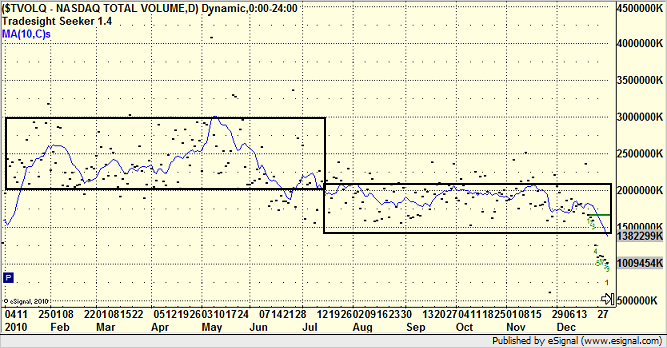
In general, another great year for Tradesight, and we have made some site changes to put a lot of our results more “front and center” going forward.
So what’s the outlook for 2011? Murky. Much more murky than the last three years. While the line “don’t fight the Fed” continues to be strongest, I have a much lower outlook for the year in general. In the end, we’re traders, and we do a good job of monitoring market direction both in a broader sense but also in an intraday sense, which really is what matters most if you are a trader. There are certainly a lot of obstacles ahead that might be relative unknowns going forward, including:
Europe – What would a complete breakdown in the Euro do
The US Debt Ceiling – Not an issue unless someone is crazy enough not to raise it
Taxes – Need to go up at some point in some fashion if you want to fix our books as spending cuts alone can’t make the difference
The Deficit – This is clearly the big one and whether 2011 will be the year that kills the market from the deficit or not remains to be seen
Oil – Anything over $100 a barrel is a problem
Metals – Gold and others aren’t just an investment tool, which is something that I think a lot of people forget. They are used in Electronics and Semiconductors, and there is a global supply and demand for this that drives the price as well, and that demand is high, but at some level, the prices push end-goods out of reach
From a trading perspective, volume will determine how well we do. You only have to look at the last week of 2010, where volume dropped to an average of only 1 billion NASDAQ shares a day and nothing moved, to see how important volume is. Unlike about 8 out of the last 10 years where I was confident in my outlook, I’m not there right now for 2011. Obviously, we’ll have up and down periods, and I suspect the volatility will be good with all of the potential news on the landscape, and that alone could be enough. If someone put a gun to my head and said “Will the year be green or red in the end,” I think I’d probably pick red, but again, that does something that you’re never supposed to do in the markets: Fight the Fed.
With QE2 out there and interest rates likely to remain low, savings finally slowing (which means people are spending); INSERT INTO `wp_posts` (`ID`, `post_author`, `post_date`, `post_date_gmt`, `post_content`, `post_title`, `post_category`, `post_excerpt`, `post_status`, `comment_status`, `ping_status`, `post_password`, `post_name`, `to_ping`, `pinged`, `post_modified`, `post_modified_gmt`, `post_content_filtered`, `post_parent`, `guid`, `menu_order`, `post_type`, `post_mime_type`, `comment_count`) VALUES and signs that construction spending is on the mend, there are certainly positive inclinations out there about the economy, but it is very possible that the markets have already factored them in and there are too many things that could “ruin” the recovery for any significant rise from here. A lot of people don’t like QE and QE2, but the reality is that they are designed to cushion the blow and give up some of the longer term “bubble gains” that we might get down the road while preventing a worse catastrophe up front.
Unemployment is always the lagging indicator and should not be viewed as what is going on in the economy. There’s no doubt that even the deeper version of unemployment data have not reached the Levels that they did in the Great Depression, but the loss of jobs in 2007 and 2008 has not recovered, as it was the deepest decline in 40 years. I have said before and I will say again now: My bigger concerns about unemployment is that we have outsourced so many jobs that we might end up in a position where the economy can run at a 3-4% GDP growth rate, the stock market can run, a lot of people will get rich, and corporations will be profitable, but unemployment won’t drop much. I’ve said before that we might need to get used to a headline 8% rate as the “new norm” in a couple of years.
So, I don’t use it as the measure of what is going to happen in the stock market. If you did, the stock market should be about 50% lower than where it is. Fed trumps unemployment data because one is a controlling factor and one is a short term symptom of the problem.
What I do hope for in 2011 is that we have the 20-25% pullback and the 20-25% runs that make for great trading environments, and I suspect that we will get that. Watch for March to be a key month as the government hits the Debt Ceiling limit. Any move toward defaulting on the full faith and credit of the US government after over 200 years or any move that results in a government shutdown would bring spending to a halt, and probably kill a couple of years of economic growth in the process. These are all important factors in the activity of the stock market, and even the Forex market. A professional trader has recognize this and be on the lookout.
Have a great 2011 and thanks for stopping by.
